Author: @YBBCapital Researcher @Ac_Core_
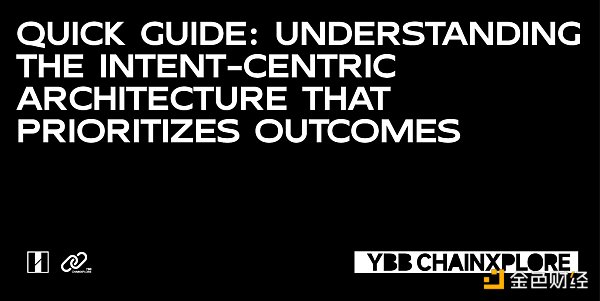
Intent is still full of risks and challenges in its execution process. It relies on intermediaries or specific executors, which can lead to risks of centralization and monopoly of power, thus affecting the trust issue of the entire middleware.
Introduction
The cumbersome user experience of Web3 has become one of the reasons hindering the large-scale adoption of blockchain. With the recent introduction of the top 10 potential trends in the encryption field by well-known Web3 venture capital firm LianGuairadigm, the concept of “Intent-Centric protocols and infrastructure” has instantly attracted industry attention. This is a design concept that revolves around user needs and considers intent as the core.
- Why does Binance Wallet consume gas like crazy? Exploring the technical and security factors behind it.
- In-depth analysis of the application of zero-knowledge proof technology the third major technological revolution in the history of blockchain development.
- An In-depth Explanation of Friend Tech’s Economic Model Game Theory, Expected Value, and Demand Curve
For example, “I want to order a $30 burger for delivery” is an “intent”. To fulfill this intent, the user only needs to enter their name, phone number, delivery address, and place the order on the delivery platform. They don’t need to worry about how the $30 payment is distributed by the merchant or how the platform allocates the delivery person and how the delivery is made. This architectural form greatly simplifies the user’s experience threshold, allowing each user to express their intent and hand over the intermediate process to various other protocols, waiting for the final result.
Note: This article is not for project promotion, suitable for general readers, and the content is for analysis and reference only.
Intent-Centric Design Principles
Background:
In the Web3 world, transactions are the most core function. Whether it is DeFi, GameFi, NFT, or any other track, they all rely on basic transactions. However, the reality is that the decentralized nature of blockchain means that different chains are independent islands. We need to find bridges that connect these islands in order to complete asset exchanges. Although centralized exchanges provide convenient user asset trading experiences, users still need to authorize wallets one by one to access numerous Dapp applications. In order to reduce the experience threshold of decentralized applications, the concept of Intent-Centric emerged.
Although the rudiment of “intent” is not a recent invention, this concept wave was triggered by LianGuairadigm, so we use their definition as a reference: “Intent is a set of signed declarative constraints that allow users to create transactions for third-party outsourcing without giving up complete control over the transaction parties.” In practice, the signing is driven by the user’s spontaneous intent, but can transferring assets to third-party outsourcing really achieve the goal of reducing user usage threshold? The following discussion will explore what is involved in achieving the vision of Intent-Centric.
What is Intent:
Intent-Centric can be understood as “centered around intent”. LianGuairadigm’s article “Intent-Based Architectures and Their Risks” published on June 1, 2023, explained the concept of intent. In the regular transaction process of users, transaction signing allows validators to verify and execute according to a specific calculation path, and the gas fee in the process is used to incentivize validators to complete the computation. However, intent does not specifically refer to a certain calculation path. Any path can achieve the final result under specific constraint conditions. In practice, by signing and sharing intents, users actually allow recipients to choose the transaction execution path on their behalf (as shown in the figure below). In order to distinguish it from transactions, we define intent as an information signature that allows for state transitions from a given initial state to retrieve multiple paths to achieve the final state result [1].

Source: Intent-Based Architectures and Their Risks – LianGuairadgim
As shown in the above figure, when submitting a transaction, a clear execution path needs to be specified, such as exchanging tokens on Uniswap. However, when submitting an intent, the execution path is determined by the matching result. For users, they only need to express their intent, and the related protocols/applications of Intent-Centric will handle the rest, including matching the execution path. In summary, a Solver is responsible for matching the execution path that meets the intent, and then waiting for the final execution and obtaining the result.
In short: Transaction = I specify how to execute it; Intent = I only want this result without caring about the implementation process.
Different preferences of intent can be matched in a complex way, and this process requires “discovering transaction counterparts” and “solver’s solving”.
Bob, the Intent Solver

Source: ETH Global
Bob the Solver is an intent-based transaction infrastructure whose main purpose is to simplify the operation process and lower the user’s participation threshold. It integrates with wallets and decentralized applications, essentially creating and executing outsourced transactions for users. It consists of two associated components:
-
Transaction creation solver: Composed of AI chatbot + intent classification + transaction optimization, it is responsible for implementing the optimal execution path of user intent and sending it to AA wallet. The solver is equipped with a machine learning (ML) model for intent classification.
-
“Abstract Account Wallet” for executing transactions: It uses the AA wallet system based on the EIP-4337 standard, composed of a bundler and a payment contract (LianGuaiymaster). It is integrated with the solver to simplify the transaction process.
Intent Layer and Solver
Is it possible to build an intent layer separately and let solvers compete for solving? Although it is theoretically feasible, it is very difficult to implement in reality. To address the core MEV problem, Anoma and SUAVE (details will be discussed in the following content) are mentioned. What characteristics are needed to safely complete asset transfers by outsourcing transactions to third parties and achieve the vision of Intent-Centric?
-
Trustworthiness
To achieve trustworthy and decentralized blockchain features, it may not be enough to have only a simple “intent network”. This cannot fulfill the guarantees of users and solvers regarding intent. After users express their intent, the Solver will calculate the specific fees required for each execution path, and the Solver will also be constrained by the adjustments set by users. Users need to know that each execution path is trustworthy.
-
Privacy
The solver provides users with the best execution path, and the complexity associated with it may be susceptible to hackers who may steal assets or obtain user information. In addition, in most cases, users’ on-chain activities are exposed to observers. To ensure the security of user information, at least some important information needs to be encrypted or hidden. However, achieving the privatization of computable information on the blockchain is very difficult.
-
Expression of Intent
Intent is an abstract concept. There are similar problems between how users express intent in blockchain and how users ask questions to AI. How should I explain it to make it understand what I want to express? For example, some expressions have implicit and unclear intentions. Will the solver generate more gas fees when choosing the execution path? An efficient and accurate parser is the key to implementing intent;
-
Maintaining Consistency between Intent and MEV
Here, taking SUAVE, an independent blockchain that solves real-world problems of the EVM, as an example, when it processes Ethereum intent, cross-chain settlement is required. Just like the great success achieved by decentralized MEV solutions such as MEV-Geth and MEV-Boost, it meets the demand for cross-chain MEV with a fairer and more transparent transaction processing mechanism;
-
Resistance to Censorship
According to LianGuairadigm’s explanation, we can see that there is a core problem. An AI-enabled parser should not exist as a single entity. If a single parser is attacked or disabled, it will cause the entire system to crash. There are also issues such as refusal to execute and incorrect execution. These issues may be resolved by Anoma mentioned in the following text;
-
Competitiveness of Solvers
Different users will have different intents, and there will be multiple transaction categories in the solver, such as exchange, cross-chain, and staking. There is no competition between single solvers because solvers can only charge fees when settling on the chain. Can we allow the solvers responsible for different transaction categories to be reasonably redistributed or optimize the parser algorithm to maintain competitiveness between solvers, so that every valid address is eligible to become a solver and successfully participate in the mempool, thereby improving transaction execution quality;
-
Intent Mempool
LianGuairadigm has proposed three new mempool solutions:
a. Permissionless Intentpools: Adopt an open design that allows anyone to submit intent to the mempool and provide unrestricted access to executors;
b. Permissioned Intentpools: Submission and execution of user intent require permission, allowing users to pass intent to a trusted third party to execute on their behalf;
c. Hybrid Solutions: Combine the characteristics of the above two mempools, aiming to strike a balance between openness and controllability.
Elements Required to Implement Intent
Account Abstraction (AA)
A brief review: Ethereum has two types of accounts: EOA (Externally Owned Account) and CA (Contract Account). The difference is that the former can initiate transactions while the latter cannot initiate transactions but can host Solidity code. Most of the accounts we use now are EOA accounts. In addition, there are multi-signature smart contract accounts (SCW) like Gonsis Safe. Since contract accounts mentioned earlier cannot initiate transactions, EOA is needed to initiate SCW, so EOA can only be responsible for signing transactions, while smart contracts can execute any logic, enhancing asset security and developing countless new application scenarios.
The implementation of the intent layer requires the abstraction of accounts (as explained in the following SUAVE section). EIP-4337 consists of six parts: UserOperation, Bundler, EntryPoint, Wallet Factory, LianGuaiymaster, and Signature Aggregator. The brief operational process is as follows:
-
Initiate user operation to execute transaction content;
-
Send the operation to the P2P “UserOperation Mempool” and have the bundler bundle and submit the signed user operation transaction content to the chain (this does not expand into various cases);
-
The bundler sends the “bundled” content to the entry point contract for processing and can optionally use the signature aggregator to check for legality;
-
The entry point contract pre-sends the transaction to the wallet contract or the LianGuai contract;
-
The LianGuai contract can have multiple types based on the project’s business logic, but it is not expanded here [2].
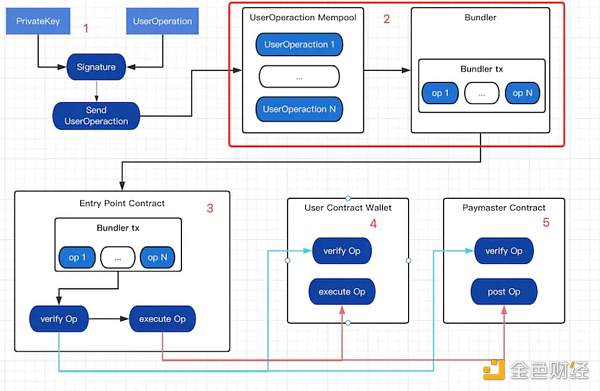
Image source: ReadON Investment Research Group
The smart contract wallet is undoubtedly the major participant in account abstraction. Currently, the main competitors are the multi-signature wallet Gnosis Safe and the Candide smart contract wallet that focuses on building full compatibility with EIP-4337. As can be seen from the analysis in the above image, account abstraction achieves the “narrow” intent suitable for developers through the bundler and LianGuai contract, while the LianGuairadigm achieves the “general” intent suitable for the general public through Solver and AI. It is appropriate to place the concepts of “abstraction” and “intent” in the same context, as they both carry a sense of order amidst chaos and magical concepts.
Programmability of Intent
According to the viewpoint of Researcher@tmel0211, the programmability of intent can be summarized as follows: if intent is not programmable, programs cannot be executed, automation is not possible, and intelligence cannot be discussed. How to understand it? Intent is a human expression of thoughts, which inherently includes emotional factors. However, it is accepted as a series of cold code and algorithms. For example, if my intent is to make money, how can code and algorithms help me find the execution path of this intent? Intent-Centric is not a completely new concept, but it is built on the simplification of existing intent designs. For this reason, existing Intent-Centric projects and concepts have been organized.
Representative projects include:
-
UniswapX: Off-chain extension intent;
-
CowSwap: Off-chain extension intent;
-
1inch: Fusion order matching off-chain + multi-DEX aggregator;
-
Solv Protocol: A completely new ERC3525 standard implementing complex financial intents;
-
Unibot: Centralized server backend preconfigured parameters, rules, and other automated intents;
-
Opensea: Off-chain signature + on-chain contract combination;
Representative concepts include:
-
ERC3525 Standard: Proposed by Solv Protocol, aims to provide a semi-decentralized asset standard that can describe digital assets in a more structured way to meet various application scenario requirements;
-
Abstract Account abstraction: Provides a standardized set of account management interfaces for abstracting the underlying implementation complexity of different types of accounts, such as gas-free, social recovery, etc.;
-
MPC Wallet: Using private key sharding technology, the private key is split into multiple parts and stored on multiple independent nodes. When performing transactions or other operations, these nodes use secure multi-party computation protocols to jointly compute signatures without the need to reconstruct the complete private key.
In summary, whether it is representative projects or concepts, they are all simplified experiences achieved through a series of more complex instructions. If the above content is divided, it can be divided into four categories:
-
Centralized intent:
Based on centralized resource matching platforms, such as Unibot and other robot trading CEX exchanges, Friend.tech, etc.;
-
Structured intent:
Based on smart contracts or proxy contract combinations, on-chain + off-chain preprocessing combinations, new ERC standards, and other preset parameters adapted for EVM virtual machine execution;
-
Distributed intent:
Based on a new distributed Solver+Executor and other blockchain architectures that do not require distribution, a new executable user intent market is built;
-
Intelligent intent:
Based on AIGC as the input+outcome carrier, programmed user’s complex intent and execute output through DeFi global training AI.
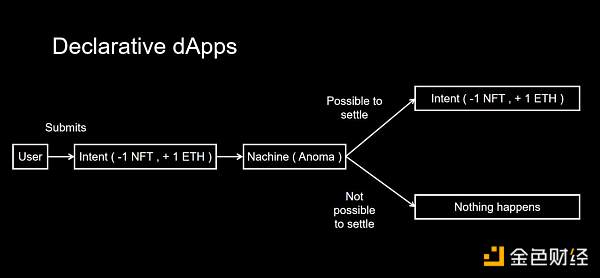
Image source: Researcher@tmel0211
MEV
Maximal Extractable Value (MEV) refers to the additional revenue rewards that miners obtain by adding, deleting, and rearranging transactions. It includes behaviors such as DEX arbitrage, front-running, back-running, liquidation, sniping bots, time-bandit attacks, sandwich attacks, etc., which harm the rights of users who use DeFi normally. In Ethereum, transactions are prioritized and sorted by miners based on gas. Transactions with higher gas are processed first, while those with lower gas are processed slowly. Transactions are first submitted to the Mempool, waiting to be included in the block. Validators extract transactions from the Mempool and add them to the next block during construction. Since the Mempool is public, searchers have the opportunity to pay fees to validators to order transactions in a specific way and extract value from users through sorting, resulting in the value of MEV for miners. To implement user intent, transactions need to be handed over to third-party outsourcing, so the MEV generated by transactions in the Intent-Centric architecture is also one of the issues that need to be paid attention to.
The most direct impact of MEV: It damages the entire network while also making the market more efficient.
-
The unequal distribution of capital (with larger holders having more ETH chips) may lead to centralization of validators (with larger staking pools getting higher MEV returns), reducing the overall security of the network. Although there are currently some mitigating measures in place, the centralization risk brought by the right to construct blocks cannot be completely eliminated;
-
In order to increase the likelihood of transactions being included in blocks, MEV-seeking miners compete with each other by auctioning gas to gain priority. This can congest the public memory pool due to high gas fee transactions from seekers. However, arbitrage and lending liquidation in DEX can also help the DeFi market reach equilibrium faster, thereby maintaining market stability.
MEV is a topic that has been explored in this industry for many years and cannot be avoided. How to mitigate the negative factors brought by MEV is also under continuous exploration. This article will explain in detail in the next section “General Solutions for Implementing Intent”. According to EigenPhi’s data as of September 15, 2023, there is still a significant profit potential for on-chain MEV, and the profit generated by Flashbots’ block-producing nodes alone after the Ethereum merger has exceeded 200,000 ETH. So this is a very large distribution of benefits.
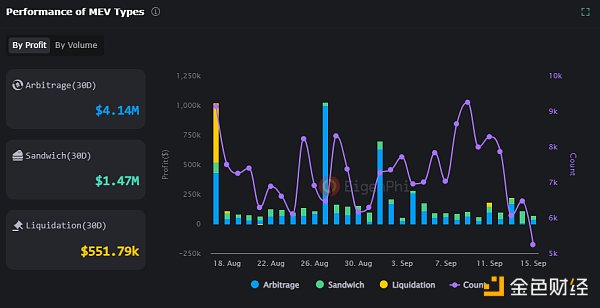
Source: EigenPhi | MEV Data
Cross-Chain, Sorters, and Oracles
Intent-Centric is a large-scale system architecture. According to LianGuairadigm’s explanation, the content of Intent-Centric involves the entire blockchain field. The massive asset transfers between various Layer1 and different Layer2 need to be passed to Intent for convenient processing. Nowadays, the development of the industry has brought us into a multi-chain era. Each chain is an island, but there are different bridges between the islands. Therefore, cross-chain and sorters are also necessary bridges to meet Intent.
Based on the prosperity of the current Ethereum Layer2 ecosystem, the four mainstream Layer3 solutions: Arbitrum, Optimism, zkSync, and Starkware, are each telling their own stories with OPstack and ZKstack. The common problem faced by Layer2 at present is the centralized sorter problem. Although feasible solutions are actively being sought, the reality is that there is a huge cake hidden here. Taking OPstack as an example, we can simply understand its profit model as “rental shops”. The profit of Layer2 = Layer2’s gas income + MEV income – Layer1’s gas expenditure. If we want to achieve our intentions, the toll between Layer2 and Layer1 is essential.
Now let’s talk about cross-chain bridges. The prosperity of Layer2 has made us realize the considerable profit of sorters early on, but the profit of cross-chain bridges should not be underestimated either. Cross-chain bridges are necessary bridges to connect different chain islands. As one of the infrastructure, besides satisfying the cross-chain needs of regular trading users in a bear market environment, there is still a market demand for cross-chain needs generated by airdrop expectations. The flourishing Dapps applications will gradually erode profits from convenient centralized exchanges. However, the security of cross-chain bridges is a noteworthy issue. According to official data from hacked.slowmist, there have been 38 publicly reported security incidents in the cross-chain bridge ecosystem from June 29, 2021 to September 16, 2023, with a cumulative financial loss of up to 2 billion USD. In conclusion, the gas fees involved in implementing intentions are inevitable, but this article does not discuss the security of sorters and cross-chain bridges, although it is an issue that deserves our attention.
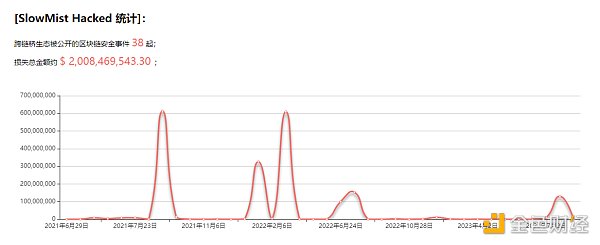
Source: hacked.slowmist
The topic comes to the oracle. From a macro perspective, the strong financial attributes of blockchain make it a system environment that pursues determinism. Even though the narrative of RWA has been discussed for many years, the reality is that blockchain cannot obtain real-world data outside the chain and can only access on-chain data. This is because the virtual machine (VM) cannot allow smart contracts to have network calls, so the operation of smart contracts must always produce consistent results. Therefore, the data of the blockchain is also closed to the outside world.
Zooming in to a micro perspective, the oracle is an important factor in the DeFi world. Although the security of different protocols is usually inherited from the underlying smart contract network, its normal operation still relies on the oracle. If an oracle of a protocol is attacked or compromised, the entire protocol will be manipulated. Nowadays, DeFi hopes to define itself as “primitives” and expects more teams to build products or combine protocols on their basis. However, in this iterative process, the new DeFi contracts derived from it will upgrade their operational logic to accommodate a larger ecological system. This also brings some external dependencies and generates unpredictable risks.
After years of development, the DeFi field has also suffered billions of dollars in theft. For example, in March of this year, Euler Finance, a lending protocol, was hacked, resulting in a loss of up to 200 million US dollars. It allows users to collateralize and borrow. The problem occurred in a specific function and did not have security checks, allowing users to break the basic invariant of the lending market (such as the basic invariant in UniSwap: tokenBalanceX * tokenBalanceY == k). Similarly, derivative protocols that rely on oracles for pricing, if lacking internal price discovery mechanisms, are easily affected by price lag and lack of updates, severely limiting their scale and user experience. This also explains why trader Avraham Eisenberg was able to successfully attack Mango Markets and withdraw 116 million US dollars from the cryptocurrency trading platform.
In summary, the dark rules of the blockchain forest are generally filled with unknown risks. There is still a long way to go to achieve the vision of Intent-Centric architecture.
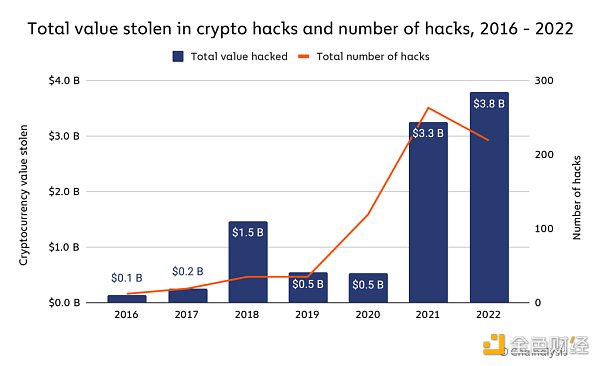
Source: Chainalysis
Aggregators and Gas
The direct purpose of aggregators is to save users the trouble of finding the best trading path and profit strategy, including various types of aggregators, such as transaction aggregators, information aggregators, yield aggregators, liquidity aggregators, and asset management aggregators. The Intent-Centric architecture requires a certain degree of centralization, and various types of aggregators may serve as convenient interpreters in the process of finding intent, providing “reference answers” to some extent.
Gas is an indispensable toll fee for executing various transactions. How to optimize gas fees is also one of the perennial topics in the industry. Currently, the overall optimization is mainly focused on product-side, account abstraction wallets, and DeFi protocols. Whether it is possible to combine aggregators, account abstraction, and DeFi protocols from a completely new product-side perspective to achieve optimized gas effects remains to be seen.
Wallet Authorization
The first step of Dapps interaction: wallet authorization. Let’s focus on the transaction itself again. The purpose of the Intent-Centric architecture is to simplify transactions and reduce user barriers. However, each transaction in each intent will involve countless authorization signatures. How to solve the authorization problem safely and conveniently is also a consideration. Perhaps account abstraction and dappOS V2 mentioned later in the text are good solutions.
A universal solution for implementing intent
Anoma
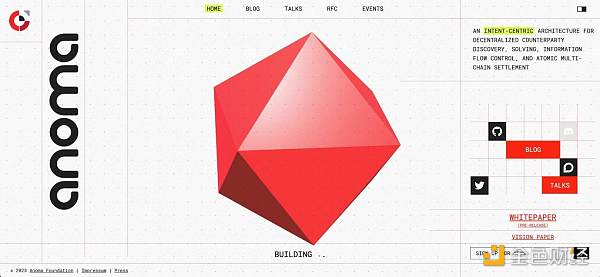
Image source: Anoma official
Introduction:
According to a report from Coindesk on May 31, 2023, the Anoma Foundation has successfully completed a total investment of 25 million US dollars from 14 capital investors including CMCC Global and Electric Capital. The project proposed the architecture of intent in the white paper released in August 2022: Intent Gossip Layer, which is used for intent dissemination, discovering transaction counterparts, and matching execution paths. Its design is the default verification path, and all dissemination (Gossip) information is signed by the issuing node, forming a signature chain that can be traced back to the initiator. This function is particularly important in terms of anti-censorship and DoS attacks (Denial of Service attacks, a method used to disrupt legitimate user access to target networks or website resources). Therefore, when it comes to the implementation of Intent-Centric, Anoma is indispensable.
Anoma was initially developed based on Tendermint and used the Byzantine Fault Tolerance (BFT) consensus mechanism, and then switched to Typhon, another PoS proof-of-stake consensus mechanism developed by Heliax, to allow consensus division between independent chains. The project team has successively developed Taiga (a private state transition framework integrated into the Intent Gossip Layer and matching layer), Typhon (cross-chain atomic transaction consensus mechanism), MASP (multi-asset shielding pool), Vamp-IR (arithmetic circuit language), Juvix (smart contract programming language), and other technologies to promote cryptography and distributed system experiments.
Continuing from the “Programmability of Intent” paragraph, to achieve the architectural vision of Intent-Centric, programmable algorithm structures and discovery of transaction counterparts are essential features. They need to be built on the basis of multi-interactivity and multi-application, which leads to the introduction of the unified architecture of full-stack decentralized applications, Anoma, to jointly build a paradigm of decentralized applications.
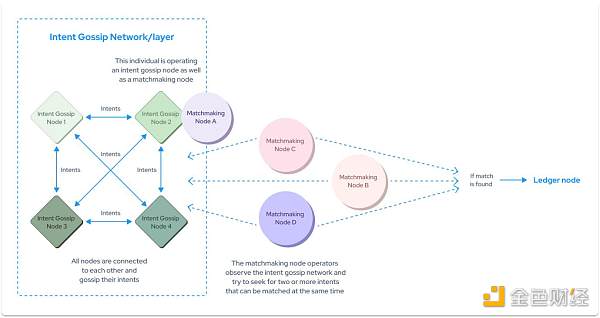
Image source: Anoma
Design Architecture and Innovations:
-
Privacy Payments
In order to protect user privacy and prevent others from tracing and collecting data, the sender, receiver, amount, and asset denominations are all encrypted. The transfer of funds is ensured through zero-knowledge proofs zk-SNARKs. What sets it apart is that it allows all assets to share a common shielding pool (MASP) to provide composable asset protection and increase user anonymity sets, rather than shielding each asset individually. The more participants and the more asset transfers, the more frequent the transfers, greatly increasing the degree of anonymity of asset transfer data;

Image source: Delphi Digital – Delphi Creative
-
Barter Trading
The project emphasizes the “barter” exchange plan, which is based on the ancient practice of trading goods for goods. In simple terms, it means exchanging goods without the need for a medium of exchange and without involving cash payments. The participants involved must have a dual coincidence of wants in order to successfully complete the trade: first, both parties happen to have the goods that the other party wants, and second, the transfer of the trade is convenient. This helps users propagate the intention to nodes operating in the intention dissemination layer and match nodes that run checks to see if these intentions are compatible, in order to create and match relevant transactions and send the corresponding execution transaction ledger. Anoma implements a digital barter plan that facilitates transactions of goods, services, or digital representations of value;
-
Intention Matching System
In Ethereum EVM, transactions do not require the future state but authorize specific execution paths. Anoma includes a matching system that allows users to broadcast transaction intentions using Gossip. In simple terms, Anoma consists of two main parts: distributed ledger and intention matching system. They complement each other and can also run independently. By running nodes, token exchange solvers, and RPC servers that request new intentions using Intent Gossip, and submitting transactions from matched intentions to the distributed ledger, it helps users automatically discover transaction counterparts;
-
Multi-Chain Support
Anoma uses the inter-blockchain communication (IBC) protocol of the Cosmos ecosystem for blockchain communication. IBC utilizes relayers to achieve data transmission between different blockchains and aims to become a multi-chain privacy layer. Currently, although relayers are usually operated by node operators, anyone capable can run them and earn fees in the process;
-
Fractal Scaling Solution
Anoma uses fractal solutions to address the scalability issue of blockchain, allowing users to create local instances to meet other transaction needs. Fractal refers to dividing Anoma into different application chains to handle different tasks, allowing each Anoma application chain to be highly customizable to achieve scalability and cope with user growth (similar to supporting the IBC protocol for scalability purposes). In the future, its security will be improved by the ⅣInterchain Security, ⅣMesh Security, and ⅣInterchain Alliance projects.
SUAVE
Introduction:
According to the news on July 25, 23, the Ethereum infrastructure service Flashbots, with a valuation of $1 billion, completed a $60 million Series B financing round to develop the SUAVE platform. SUAVE (Single Unified Auction for Value Expression) separates the memory pool and block generation from the existing blockchain to form a separate blockchain network (ordering layer) and provides highly specialized plug-and-play alternative solutions [4] to address infrastructure-related challenges in MEV.
Although SUAVE is a new blockchain, it is not a general-purpose smart contract platform that can compete with Ethereum or any other participating chains. If Anoma is compared to a blockchain built with intention in mind, then SUAVE is a blockchain infrastructure built with intention in mind.
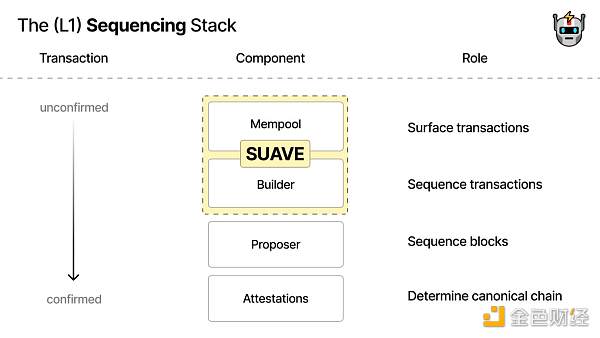
Image source: SUAVE in the blockchain stack
Three goals of SUAVE:
-
Illuminate the Dark Forest: Expose unfair events in the current opaque MEV ecosystem to every user, quantify their impact, and break down information barriers between participants;
-
Democratic Mining: Integrate miners and retrievers in an open manner, promote competition among all parties in the most inclusive way, and provide free access to all miners to prevent MEV integration and centralization;
-
Benefit Distribution: Give MEV to the people who create it – Ethereum users.
According to the intention solution of SUAVE, when processing transactions from external chains (such as Ethereum), cross-chain settlement is required. It can be used to attempt to solve various risks in the EVM, similar to the huge success achieved by MEV decentralized solutions such as MEV-Geth and MEV-Boost. However, it should be noted that users will deposit funds into SUAVE during the process of implementing their intentions, and in the process of unlocking funds when their demands are resolved, the smart contracts on SUAVE will involve asset verification and may have all the risks of cross-chain bridges today to some extent.
From SCW and AA to SUAVE and Intent-centric:
Looking back at the “Account Abstraction AA” section, and considering the main functions brought about by account abstraction: key recovery, gasless payments, multi-signature authorization, multiple transfers in a single transaction, fee limits, etc., overall, account abstraction perfectly combines the advantages and functional features of regular accounts (EOA) and smart contract accounts (CA).
SUAVE’s vision is to become a common ordering layer between different chains (including cross-chain transactions and MEV). Therefore, when user intentions involve cross-chain asset transfers, account abstraction (AA) and multi-signature smart contract accounts like Gonsis Safe (SCW) combine the advantages of both parties, combined with SUAVE’s EVM solution, perhaps it is currently theoretically a better solution.
CoWSwap

Image source: CoW Protocol
Introduction:
If we were to choose the project that is closest to the Intent-Centric architecture, CoWSwap would definitely be on the list. Unlike other protocols, its protocol allows users to simply send a signed order to delegate the execution of the transaction to the resolver network, which will complete the transaction within the network (without specifying the execution path). At the same time, off-chain signed orders will be executed after being matched by the resolver (similar to Bob Solver mentioned earlier, but different), and due to the resolver’s “batch bundling” authority, the gas fees during the process will be borne by the resolver and there is no need to pay in case of transaction failure.
CoWSwap Hooks:
When talking about Hooks, do we think of Uniswap V4? However, the actual functions of the two are completely different. CoW Hooks connects transactions, bridging, staking, and depositing together, and can execute transaction sequencing before/after the execution of the order in the form of a single transaction.
Main functions:
-
Pre-hooks can be used to “set” conditions for orders. For example, code required to verify on-chain signatures or approval settings required by EIP-2612;
-
Post-hooks are executed after the exchange occurs and the receiving address receives the funds. Post-hooks provide an opportunity to immediately use the funds, including pledging, providing liquidity, bridging tokens to L2, etc.
DeFi examples of CoW Hooks:
-
Debt repayment and staking: Set the pre-hook operation to repay debt and liquidate, then use CoW Swap to exchange assets, and finally deposit the new assets into the reserve fund using the post-hook operation;
-
Create LP positions: Use pre-hook transactions only or post-hook transactions only;
-
JIT (Just-in-Time) smart orders: Use the composable CoW framework (ERC-1271) to program Safe smart contract wallets to execute custom smart contract approvals and exchanges;
-
NFT: Can sell or buy NFTs in the CoW Hooks function;
-
Cross-chain: Can send assets to bridging contracts through Cow Hooks to complete cross-chain transactions;
-
Airdrops: Can sell airdrops using CoW Hooks without using ETH as gas;
-
Unlocking and re-staking: If you have staked 32 ETH as a validator, you can unbind to claim rewards, or you can re-stake assets on other chains through CoW Hooks;
-
Automatically increase LP positions: Assume that you become a liquidity provider for the EUR-USDC pool on the Gnosis chain to receive GNO token rewards. You can use CoW Hooks to automatically convert your GNO to EUR-USDC in a 50/50 ratio through CoW Swap, thereby automatically increasing your LP position.
dappOS V2
After discussing the intent layer and related infrastructure layer, let’s explore the dappOS V2 protocol, which is hailed as the “new wave of intent layer”. On July 21, 2023, dappOS V2, which is valued at up to 50 million USD, completed a seed round of financing led by IDG Capital and Sequoia Capital (China), and also attracted attention from other major VC institutions and Binance.
dappOS V2 is an intent protocol that references dappOS accounts and the dappOS network, aiming to simplify user interaction with dApps and achieve a user experience similar to CeFi (Centralized Finance). At the same time, it eliminates the fragmentation barriers caused by multiple chains through “Chain Abstraction” technology (similar to post-account abstraction).

Image source: Intent-Centric A Narrative worth keeping an eye
Whether it is intent-driven or transaction-driven, the user’s focus is always on the total amount of funds in the account, rather than the individual asset balances between different chains. According to the understanding of dappOS V2, there should be a unified account wallet here to achieve the vision of “one signature completes everything”. It introduces the design concept of one-click multiple “TXN (Transaction)” to remove barriers for users before completing TXN and achieve transaction purposes guided by intent.
For example, it can be borrowed to achieve interaction with GMX between Arbitrum and Avalanche chains without assets, thereby achieving the future DeFi rule of intent-centric basic transactions. Therefore, implementing the concept of intent-centricity requires involvement of chain abstraction, account abstraction, and more “protocol abstractions”. However, when it comes to this, we need to consider a question: If all kinds of abstractions can be implemented, will the interaction rules for users and the airdrop rules for various projects change?
Summary:
Intent is still filled with risks and challenges in its execution. It relies on intermediaries or specific executors, which may lead to the risk of centralization and monopoly, thereby affecting trust issues across the entire middleware. Secondly, the security and privacy risks brought by handing over transactions to third-party execution also need to be considered. It is also highly anticipated whether developers of intent applications can achieve a balance between security, privacy, and convenience.
The concept of intent has been relatively maturely applied in the Web2 field, such as ride-hailing software, ticketing software, and map navigation. However, the success of these applications is based on the sound foundation of the Web2 infrastructure. To see mature application scenarios in the Web3 field, we still need to wait for the continuous maturity of the industry. Intent-Centric is a grand concept that involves various aspects of blockchain and is also one of the best paths for combining blockchain with AI. However, whether it can land, develop, and flourish still requires our continuous attention.
Explanatory literature and reference articles:
【1】https://www.paradigm.xyz/2023/06/intents
【2】https://mirror.xyz/0x7333aB7AE068Ef92fb77A2bcab32FA273c45185c/ozUKb4RdhqB4ya49uw_OfMHILiZpDBV99eosD9gfumU
【3】https://www.alchemy.com/overviews/what-is-a-mempool
【4】https://writings.flashbots.net/the-future-of-mev-is-suave/#iv-suave-in-the-blockchain-stack
Like what you're reading? Subscribe to our top stories.
We will continue to update Gambling Chain; if you have any questions or suggestions, please contact us!